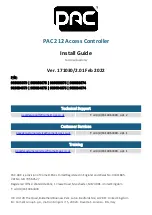
ADV
ANCEINFORMA
TION
Wakeup
Signal
X1/X2 or
XCLKIN
XCLKOUT
Flushing Pipeline
(A)
Device
Status
STANDBY
Normal Execution
STANDBY
(G)
(B)
(C)
(D)(E)
(F)
t
d(IDLE-XCOS)
t
w(WAKE-INT)
t
d(WAKE-STBY)
TMS320F28377S, TMS320F28376S, TMS320F28375S, TMS320F28374S
SPRS881A – AUGUST 2014 – REVISED JUNE 2015
A.
IDLE instruction is executed to put the device into STANDBY mode.
B.
The LPM block responds to the STANDBY signal, SYSCLK is held for a maximum 16 INTOSC1 clock cycles before
being turned off. This delay enables the CPU pipeline and any other pending operations to flush properly.
C.
Clock to the peripherals are turned off. However, the PLL and watchdog are not shut down. The device is now in
STANDBY mode. After the IDLE instruction is executed, a delay of five OSCCLK cycles (minimum) is needed before
the wakeup signal could be asserted.
D.
The external wakeup signal is driven active.
E.
The wakeup signal fed to a GPIO pin to wake up the device must meet the minimum pulse width requirement.
Furthermore, this signal must be free of glitches. If a noisy signal is fed to a GPIO pin, the wakeup behavior of the
device will not be deterministic and the device may not exit low-power mode for subsequent wakeup pulses.
F.
After a latency period, the STANDBY mode is exited.
G.
Normal execution resumes. The device will respond to the interrupt (if enabled).
Figure 5-15. STANDBY Entry and Exit Timing Diagram
Copyright © 2014–2015, Texas Instruments Incorporated
Specifications
77
Product Folder Links:
















































